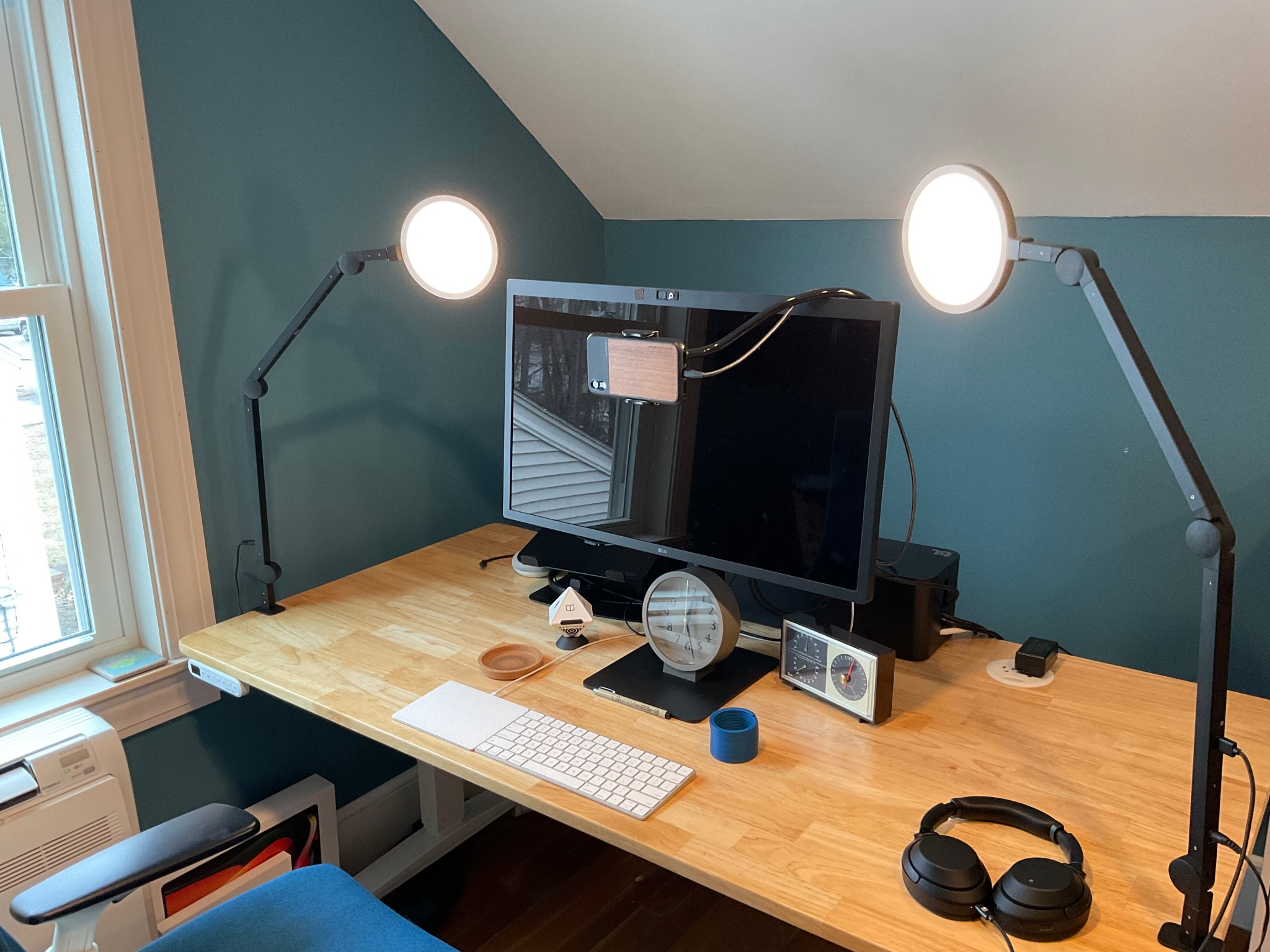The 80/20 Rule of Webcam Quality

One topic I’ve been monitoring during the pandemic is the availability of tools for producing better webcam quality. With so many more people suddenly logging onto Zoom to spend time with family and conduct their work, I’ve been waiting for capitalism to step in and offer better options.
Despite some interesting kickstarters, I haven’t seen what I’m looking for yet. Something elegant, affordable, and portable. That doesn’t mean there aren’t options.
This is my journey to much better video quality with very little effort.
If you’re interested in good image quality for video calls, I would start by reading these:
- Stream Like a CEO by Matt Mullenweg
- 2021 Streaming Kit – a follow-up by Matt
- So You’re Thinking About a Fancy Camera Rig by Stephen O’Grady on the Redmonk blog
Matt’s 2021 Streaming Kit is probably the best example of what you can achieve if you want to go deep on this subject. But it means going deep.
In short, then, I recommend not going down this path. When you see someone on a video call with an impressive bokeh-ed image, just let it go and call yourself lucky. It’s not too late to save yourself.
— Stephen O’Grady, So You’re Thinking About a Fancy Camera Rig
Stephen O’Grady’s words of warning in So You’re Thinking About a Fancy Camera Rig rang true for me. I don’t take video calls often (2-8hrs/wk), so I’m not willing to invest a lot in it (time or money).
I strikes me that there’s a chasm of quality that exists between high-end setups using DSLR cameras, and the pinhole camera embedded in a laptop screen that almost everyone uses. Most people look at the cost of reaching 100% and choose to never get started. I hope that changes, mostly because I’d like to see people better on calls and feel like we’re both making eye contact.
Key Elements
That Bokeh
Obviously this is the big one. To get this, you’ll need 2 things:
Camera Quality: a decent camera with a wide aperture, allowing more light into the camera, which creates a narrow depth of field. You’ll see this represented in f-stop. In college I shot & developed b&w film on a Minolta x370 with an f1.4 50mm fixed lens, which was perfect.
Light Quality: Cameras capture light. Simple as that. It will be important to identify the location of your light, the color temperature of the light, and any natural light in the room where you work.
Eye Contact
This one is really important and was difficult to figure out. There’s just nothing as engaging as feeling like someone is looking directly at you when they’re speaking. As a society we’ve grown so used to seeing people looking elsewhere on video calls. Seeing someone making eye contact on a video call is especially engaging and surprising – like a dramatic demonstration of focus.
The only way to get this effect is by positioning the camera so you’re looking into it.
My Very Simple Setup
Camera
I use an iPhone XR, which is unique in that it only has one rear-facing camera, but still has portrait-mode. This gives me a slight bokeh out of the box with no effort.
Using Camo Studio, I connect the phone to my computer via a USB-C => Lightning cable, which gives me both a reliable video feed and a dedicated power source.
Lighting
In my home office, there are 3 recessed lights overhead, and a large window to my left. I noticed that calls during the daytime are pretty decent without additional lighting. But during the winter when it gets dark at 4pm, it’s really difficult to get a decent image, and the white balance shifts yellow.
I upgraded my workspace to use two Lume Edge Lights, which are anchored on the left & right sides of my desk as a 2-point system, ensuring there are no casted shadows on my face. These are great for a few reasons:
- The light heads swivel, so I use them as downward-facing workspace lamps most of the time, and then flip the lights towards my face when I take a call.
- You can adjust the color temperature (yellow=>white) and brightness of the lights easily, which allows you to compensate for natural light and tune the white balance of your image, naturally.
Eye Contact
I spent a bunch of time thinking about this, and decided to surf Amazon to see what I could find. I landed on a $15 flexible arm, which clamps to the stand for my monitor, and wraps around to hold my phone directly in front of my screen.
This means I reposition my call window to sit just below the camera, so I can see who I’m talking to, and I’m making eye contact with them at the same time. It mimics a teleprompter, but with so much less effort.
The great part about the flexible arm is that I can easily bend it out of the way behind the monitor when not in use.
Results
These are actual screenshots I took of my square during a series of Google Meet calls one day:
- LG 5k Display Webcam
- iPhone XR + Camo with Room Lights
- iPhone XR + Camo with Lume Edge Lights
I’ve been using this setup for a little over a month now, and I’ve been pretty happy with it overall. It’s a little extra work to plug in my phone and mount it each time I jump on a call, but it feels like a good effort/value ratio.
It’s tempting to want to go further – maybe a nicer camera, or trying some different mounting options. But like Stephen O’Grady suggested, I’ll probably just consider myself lucky and let it go so I can focus on other things.
